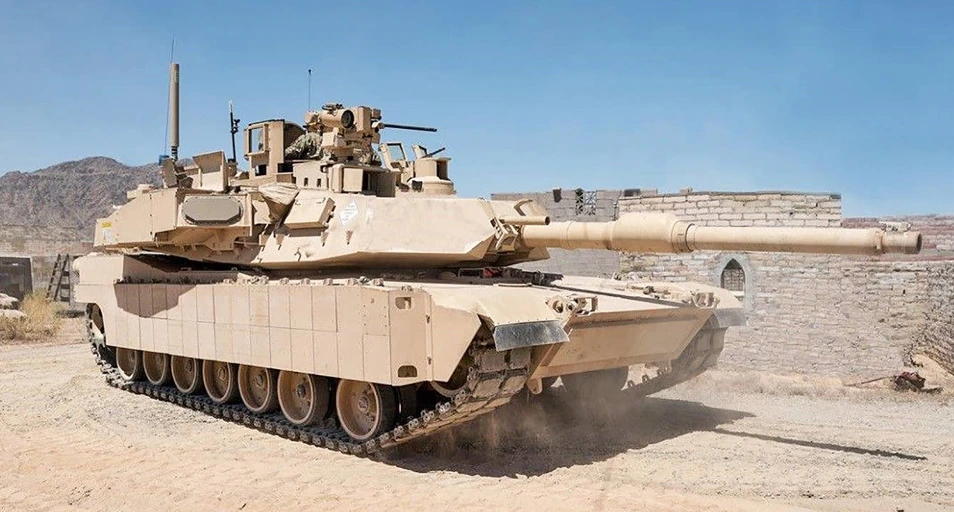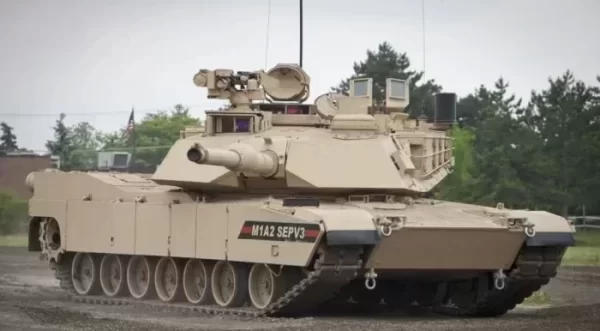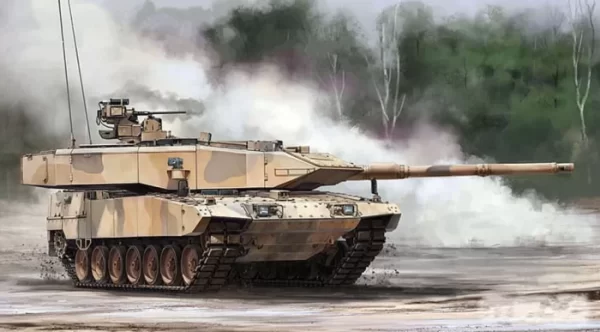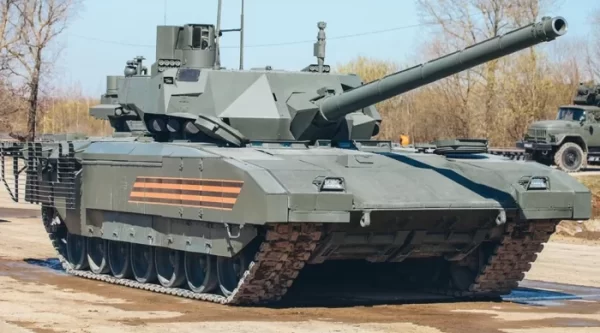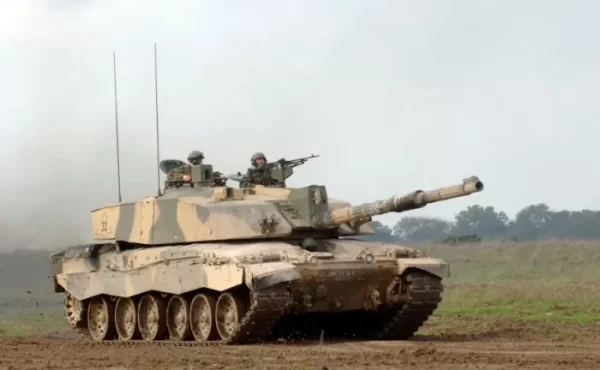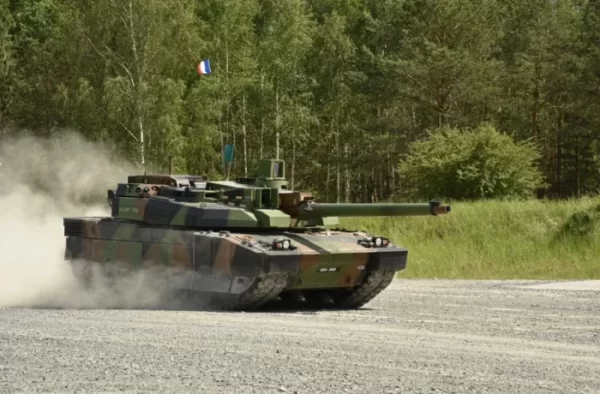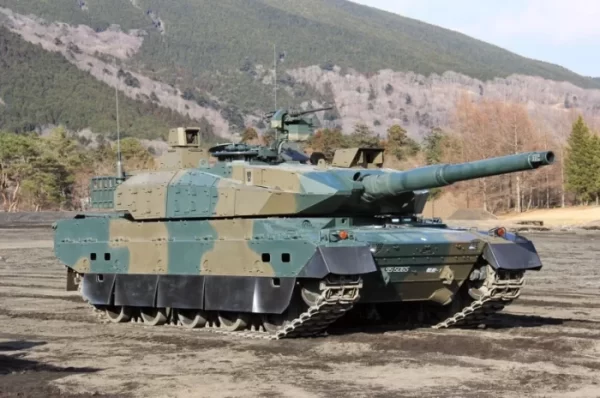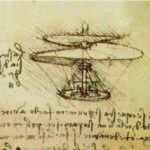Modern Tanks
Modern tanks, the successors of early 20th-century armored beasts, now dominate 21st-century battlefields. Evolved from World War I origins, these military goliaths, armored and armed, are symbols of contemporary warfare’s power and precision, symbolizing a fascinating journey from mechanical infancy to technological pinnacle.
From their infancy as slow, lumbering metal boxes to the swift, technologically sophisticated powerhouses of today, the story of tanks is a journey marked by innovation and adaptation. The tanks of the modern era are a far cry from their early predecessors, both in terms of capabilities and design. For example, consider the conceptual designs of Leonardo da Vinci, a man far ahead of his time. Da Vinci’s designs hinted at the potential of armored warfare, a potential fully realized in the modern tanks we see today.
The Most Modern Tanks
A tank that embodies this leap in technology is the T-14 Armata, a shining example of the latest in Russian modern tank design. When we peel back its layers, we find that beneath the Armata’s menacing exterior lies a symphony of high-tech features. Its unmanned turret, a groundbreaking feature, is controlled remotely from within the tank, providing an unprecedented level of safety for its crew.
As we move westwards, we come face to face with another giant in modern tank technology: the M1A2 SEP v3 Abrams. This modern US tank features a range of improvements over its predecessor, including enhanced armor and high-tech systems that increase its effectiveness on the battlefield. With a new ammunition data link for improved targeting and an Auxiliary Power Unit (APU) for increased efficiency, the Abrams is an impressive showcase of US engineering prowess.
But technological mastery isn’t confined to the West. The East has its own mechanical marvel in the form of the Type 10, a modern Japanese tank that fuses high-tech weaponry with cutting-edge defensive capabilities. With advanced Composite Armour and a digital battlefield management system, the Type 10 stands tall as a testament to Japan’s technological prowess.
The Powerhouses of Modern Warfare
Stepping onto the global stage, we find a lineup of the world’s best modern tanks, each a paragon of their respective nation’s ingenuity and military prowess. From the Abrams tank of the United States to the Leopard tank of Germany, these modern tanks are the linchpins of their countries’ land warfare strategies.
The Abrams: American Powerhouse
First up is the modern US tank, the M1A2 SEP v3 Abrams. This beast of a machine is like a mechanical Hercules, known for its strength and durability. The Abrams boasts impressive firepower and can absorb heavy punishment with its advanced composite armor. A testament to the United States’ military might, the Abrams remains one of the top contenders in the world of modern tanks.
The Leopard: Germany’s Swift Predator
Moving to Europe, we find Germany’s answer to the Abrams: the Leopard 2A7. Known as one of the best modern German tanks, the Leopard combines speed, maneuverability, and impressive firepower. Its high-velocity 120mm gun ensures it packs a punch, while its advanced protection systems mean it can hold its own in a slugfest.
The Armata: Russia’s Modern Marvel
Shifting our gaze eastwards, we find the T-14 Armata, a shining example of modern Russian tanks. With its unmanned turret and next-generation armor, the Armata represents a step forward in tank technology, displaying a unique blend of power and innovation that marks Russia’s place in modern tank warfare.
The Challenger 2: Britain’s Reliable Workhorse
Next up is the Challenger 2, the stalwart of modern British tanks. Renowned for its exceptional durability, the Challenger 2 holds the record for longest tank-to-tank kill. Its combination of superb armor and reliable systems make it a formidable component of the UK’s military arsenal.
The Leclerc: French Technological Elegance
From France comes the AMX Leclerc, a modern French tank that merges speed, technology, and firepower. Known for its high level of automation and excellent mobility, the Leclerc is a symbol of French sophistication and military know-how.
The Type 10: Japan’s Tech-Savvy Titan
Finally, we turn to the Far East, where the Type 10, a Japanese modern tank, stands out with its advanced digital systems and high-tech armor. The Type 10’s compact design and excellent maneuverability make it well-suited for Japan’s rugged terrain, showcasing the country’s innovative approach to tank design.
Each of these tanks, from the robust Abrams to the technologically advanced Type 10, brings its unique strengths to the battlefield. This variety and specialization are a reflection of the complex nature of modern warfare, where different situations call for different tools. As we move forward, these tanks will continue to evolve, a testament to the ever-changing nature of warfare and the relentless drive for advancement.
Spotlight on the US Abrams Tank
Among the world’s modern tanks, the Abrams tank, a key player in the US’s lineup of modern tanks, stands out. With its imposing silhouette, the Abrams is not just a symbol of American power; it’s a living testament to the United States’ commitment to military superiority.
Birth of a Beast
The Abrams tank, named after General Creighton Abrams, the former Army Chief of Staff, entered service in 1980. Designed to replace the aging M60 Patton, the M1 Abrams was a quantum leap forward in tank technology, boasting advanced armor, high-speed mobility, and immense firepower. Over time, the Abrams has been upgraded and refined, resulting in the current version, the M1A2 SEP v3, a truly modern US tank.
Unyielding and Unstoppable
The Abrams tank is an embodiment of raw power. Its 120mm smoothbore gun delivers devastating firepower, while its advanced Chobham armor offers impressive protection. With a gas turbine engine that can propel it at speeds up to 60 mph, the Abrams is as swift as it is deadly.
On the technology front, the Abrams is equally impressive. Its advanced fire control system allows for accurate targeting in both day and night conditions, while its suite of sensors and systems provides a level of situational awareness unparalleled among tanks.
Tested in Battle
The Abrams’ capabilities aren’t just theoretical; they’ve been tested and proven on the battlefield. From the scorching deserts of Iraq in the Gulf War and subsequent Iraq War to the rugged mountains of Afghanistan, the Abrams has faced a wide range of threats and has consistently emerged victorious.
However, it’s worth noting that the Abrams is not invincible. Has the US ever lost an Abrams tank? Yes, they have. Despite the Abrams’ impressive capabilities, a few have been lost in combat, primarily due to Improvised Explosive Devices (IEDs) and RPGs. Such losses are a stark reminder that even the most powerful tanks have vulnerabilities.
Despite these losses, the Abrams remains one of the most formidable tanks in the world. Its combination of power, protection, and advanced technology make it a key asset in the US military arsenal and a symbol of American military might.
The Leopard vs. Abrams Showdown
When it comes to the world’s best modern tanks, two names often surface to the top of the list: the American Abrams tank and the German Leopard 2 tank. These mechanical titans, each boasting a mix of speed, power, and armor, represent the pinnacle of their respective nation’s military engineering prowess. But, which one reigns supreme? Is the Leopard 2 better than the Abrams?
Table 1. Comparison between Leopard 2 and Abrams tanks
| Features | Leopard 2 (Germany) | Abrams (USA) |
|---|---|---|
| Nickname | Swift Predator | Ironclad Juggernaut |
| Manufacturer | Germany | United States |
| Main Gun | 120mm smoothbore gun | 120mm smoothbore gun |
| Special Focus | Speed, Agility, and High-Tech Firepower | Superior Armor and Survivability |
| Mobility | Superior – thanks to a powerful multi-fuel engine and advanced suspension system | High – but not specifically highlighted in comparison to Leopard 2 |
| Advanced Tech | Digital fire control systems, advanced optics, and sophisticated thermal imaging system | Advanced fire control system, sensors, and targeting system |
| Armor | Not specified | Advanced composite armor (Chobham armor) |
| Survivability | Not specifically highlighted | High – designed to withstand high-explosive anti-tank (HEAT) rounds and kinetic energy penetrators |
| Ability to Engage Targets | High accuracy in various combat conditions | Accurate in both day and night conditions, can track and engage moving targets while on the move |
| Terrain Versatility | Can traverse challenging terrain at high speeds | Not specified |
Therefore, is the Leopard 2 better than the Abrams? The answer isn’t straightforward. The Leopard 2’s emphasis on speed and advanced technology make it an exceptional offensive weapon, capable of rapid strike and maneuver warfare. The Abrams, with its superior armor and survivability, is an ideal defensive weapon, able to absorb heavy punishment while delivering devastating counterattacks.
In the end, the choice between the Leopard 2 and the Abrams largely depends on the specific mission, terrain, and tactical doctrine. Both tanks represent the zenith of modern tank technology, and each offers a unique blend of capabilities that make it a formidable contender on the battlefield.
The Evolution of Tank Technology
Since their inception during the First World War, tanks have experienced an extraordinary evolution. Over the decades, they’ve transformed from slow, lumbering ironclads into technologically advanced powerhouses. Let’s trace this remarkable progression of tank technology, from the early main battle tanks to the modern day tanks we see today.
- The Birth of the Main Battle Tank: The story begins with the birth of the main battle tank, a concept that arose following the Second World War. These vehicles were designed to perform multiple roles on the battlefield, combining the firepower of heavy tanks, the mobility of medium tanks, and the armor of infantry tanks. They were the precursors to the modern tanks we see today.
- Advancements in Armor and Firepower: One of the most significant advancements in tank technology was the development of composite and reactive armor, greatly enhancing tanks’ defensive capabilities. Compare this to the tanks of World War 2, which relied mostly on increased thickness of traditional steel armor. Firepower also saw vast improvements. Most modern tanks now use smoothbore guns capable of firing a variety of rounds, including APFSDS and HEAT. Some even incorporate advanced fire control systems for better accuracy, something that World War 2 tanks could only dream of.
- The Rise of Light and Modern Tanks: While heavy main battle tanks like the Abrams and Leopard 2 often steal the spotlight, there’s also been an emergence of modern light tanks. These vehicles are designed for operations that require high mobility, flexibility, and adaptability, often featuring advanced digital systems for communications, targeting, and reconnaissance.
- The Digital Revolution: Modern Day Tanks: Perhaps the most transformative change in tank technology has been the digital revolution. Modern day tanks are now more akin to rolling computers, equipped with GPS, digital communications, and advanced sensor systems. These technologies allow for improved coordination, real-time updates, and enhanced situational awareness, giving modern tanks a level of strategic capability that surpasses anything seen in previous eras.
The evolution of tank technology is a fascinating journey, marked by continuous innovation and adaptation. As we move into the future, it will be interesting to see what new developments await in the world of tanks. From improvements in stealth technology to the potential use of unmanned systems, the story of the tank is far from over.
The Most Dangerous Tanks in the World
Over the years, tanks have evolved into highly sophisticated war machines, capable of inflicting massive damage and asserting battlefield dominance. But among these metal beasts, a few stand out as truly lethal — the most dangerous tanks in the world.
Table 2. The most dangerous tanks in the world
| Rank | Name | Country | Nickname | Key Features |
|---|---|---|---|---|
| 1 | Abrams | USA | America’s Shield and Sword | Formidable armor, advanced fire control systems, devastating firepower, a perfect balance of speed, firepower, and protection |
| 2 | Leopard 2 | Germany | Europe’s Swift Executioner | Impressive speed, cutting-edge technology, high-caliber firepower |
| 3 | T-14 Armata | Russia | Russia’s Futuristic Titan | First fully automated tank, unmanned turret, high-tech armor, ability to detect and engage targets from a great distance |
| 4 | Type 99 | China | China’s Eastern Dragon | Advanced composite armor, powerful 125mm smoothbore gun, state-of-the-art electronic warfare systems |
The most dangerous tanks in the world represent a perfect blend of power, protection, and advanced technology. They are the apex predators of modern warfare, bringing a level of destruction and dominance that cements their place at the top of the food chain.
The Ranking of Modern Tanks
From the plains of Europe to the deserts of the Middle East, modern tanks play an instrumental role in warfare. But which of these armored titans reigns supreme? Let’s delve into the ranks and capabilities of the modern tanks of the world.
Table 3. Ranking of modern tanks
| Rank | Name | Country | Nickname | Key Features |
|---|---|---|---|---|
| 1 | M1 Abrams | USA | America’s Armored Pride | 120mm smoothbore cannon, state-of-the-art composite armor, gas turbine engine (speeds up to 60 mph on highways), exceptional blend of firepower, speed, and defensive capabilities |
| 2 | Leopard 2 | Germany | Europe’s Finest | Reliability, firepower, advanced technology, high-tech features including fire control system and 120mm smoothbore gun |
| 3 | T-14 Armata | Russia | Russia’s Advanced Vanguard | Unmanned turret, remote-controlled gun, new-generation armor offering superior protection, one of the most technologically advanced tanks |
| 4 | Merkava Mk.4 | Israel | Israel’s Desert Shield | Engine at the front for added crew protection, high-performance 120mm gun, advanced armor, unique design focused on crew survival |
| 5 | Type 99 | China | China’s Eastern Juggernaut | Advanced technology, high speed, 125mm smoothbore gun, represents a new generation of Chinese armored warfare |
These modern tanks of the world showcase the pinnacle of armored technology and combat effectiveness. Despite the varying philosophies behind their designs, they all share one thing in common: they are the best in their class, offering unparalleled power on the battlefield.
The Newest Tanks Rumbling onto the Battlefield
Modern warfare is a constantly evolving landscape, with nations around the globe always striving to develop superior armored vehicles to maintain battlefield dominance. Let’s dive into the world of the newest U.S. tanks and other modern additions to armored divisions worldwide.
Table 4. Newest tanks rumbling onto the battlefield
| Name | Country | Nickname | Key Features | Status |
|---|---|---|---|---|
| M1A3 Abrams | USA | The Next Generation of U.S. Power | Significant enhancements in terms of weight, power, and digital capabilities | Under Development |
| Leopard 2A7V | Germany | Germany’s Latest Feline | Improved cooling system, new digital systems for increased battlefield awareness, enhanced mine protection | Recently Introduced |
| T-14 Armata | Russia | Russia’s Fully Automated Behemoth | World’s first fully automated tank, high-tech systems, formidable firepower | Recently Deployed |
| Type 15 | China | China’s Lightweight Champion | Designed for operations in rugged terrain and high-altitude regions where heavier tanks struggle | Newest Addition |
The newest U.S. tank and other recent additions to global tank arsenals highlight the ongoing advancements in armored warfare. With each nation bringing unique strengths and technological innovations to the table, the future of tank warfare promises to be as dynamic as it is destructive.
The Latest Tank Technology
Modern tank technology is not just about firepower and armor. It encompasses advancements in communication, mobility, and energy efficiency. This article delves into the latest advancements that are shaping the future of armored warfare.
- Fuel-Efficient Power Systems: The modern fuel tanks used in the latest tanks reflect significant improvements in fuel efficiency and energy use. For example, the M1A3 Abrams, currently under development, aims to replace its gas turbine engine with a more fuel-efficient diesel engine. These enhancements mean tanks can stay in combat for longer periods without needing refueling, thereby enhancing their operational effectiveness.
- Active Protection Systems: Active Protection Systems (APS) are a game-changing advancement in modern tank technology. APS are designed to detect and neutralize incoming projectiles before they can strike the tank. Israel’s Merkava Mk.4 uses the Trophy APS, which has proven highly effective in real-world combat situations. The adoption of APS systems represents a paradigm shift in the way tanks are defended.
- Unmanned Turrets and Remote Weapon Stations: The future of tank technology may lie with unmanned systems. The Russian T-14 Armata utilizes an unmanned turret, which is a significant departure from traditional tank design. This not only reduces the crew’s vulnerability but also allows for a more flexible and streamlined tank design.
- Digital Systems and Artificial Intelligence: The incorporation of digital systems and artificial intelligence (AI) is a groundbreaking development in tank technology. Advanced communication and information systems, such as those in the Leopard 2A7V, enhance battlefield awareness and improve decision-making. The integration of AI can also automate various processes, thereby reducing the workload on the crew and increasing operational efficiency.
In conclusion, the latest military tank technology is revolutionizing the face of armored warfare. With the integration of modern fuel tanks, advanced protection systems, unmanned components, and artificial intelligence, the future of tank warfare promises to be an arena of intense technological competition.
Tanks in Popular Culture
The influence of tanks extends far beyond the battlefield, making substantial impressions on popular culture. From iconic famous tank names in video games to the representation of armored vehicles in art installations, let’s explore the unique intersections of tank culture with the realms of gaming and art.
Revving Up Gaming: Modern Tanks Game
Modern tank warfare has become a significant part of the gaming industry, with several games offering tank enthusiasts a chance to experience the thrill of armored combat. The globally popular game, “World of Tanks,” features historically accurate famous tank names like the “M1 Abrams,” “Tiger I,” and “T-34,” giving players an immersive experience of controlling these mechanical beasts.
Another prominent example is the “Armored Warfare” game. Set in a modern or near-future era, it allows players to command cutting-edge tanks such as the Leopard 2A7 or the T-14 Armata, accurately simulating their unique capabilities.
Tanks in the Artistic Spotlight: Tate Modern Tanks
Tanks have also rumbled into the realm of art, with the Tate Modern Tanks offering a prominent example. The Tate Modern, a renowned contemporary art museum in London, converted three enormous former oil tanks into unique gallery spaces. These industrial spaces host a variety of installations and performances, bringing a different kind of ‘tank’ into cultural prominence.
In other instances, tanks themselves have become the canvas for artistic expression. For example, the famous T-34 tank, painted pink and adorned with a giant raised middle finger, was a prominent art installation in Prague as a form of protest art.
Conclusion
From their origins in the muddy trenches of World War I to their dominant position on today’s battlefields, tanks have evolved into a crucial component of modern warfare. With the rise of modern tanks, the landscape of combat has been transformed, making them a pivotal part of national defense strategies worldwide.
The top-tier tanks of the world, such as the Abrams and Leopard tanks, are testament to the breathtaking technological advancements and strategic prowess of modern militaries. Despite their differences, these tanks share the common characteristics of unmatched firepower, solid armor protection, superior mobility, and cutting-edge technology. They have played significant roles in modern conflicts and stand as the embodiment of military might and ingenuity.
